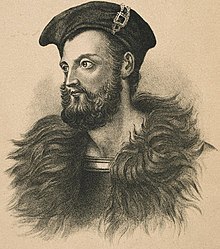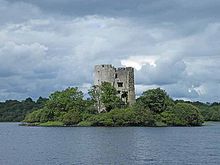Eoghan Rua Ó Néill
Eoghan Rua Ó Néill [ oːn̪ ɾuːə oː neːl ] (older Irish orthography Eoghan Ruadh Ó Néill , Anglicized Owen Roe O'Neill , Spanish Don Eugenio O'Neill ; * 1590 ; † November 6, 1649 ) was an Irish military leader of the 17th century and one of the most famous members of the Uí Néill dynasty in Ulster .
birth
Ó Néill was the son of Art Mac to Bharúin Ó Néill, a younger brother of Aodh Mór Ó Néill, 2nd Earl of Tyrone (the Great Ó Néill), who owned land in County Armagh . Eoghan Rua's mother was the daughter of Aodh Conallach Ó Raghallaigh, king of Bréifne Ó Raghallaigh in what is now County Cavan .
In Spanish service
As a young man, Eoghan Rua left Ireland as one of 99 Irish nobles who fled while the counts fled from the English conquest of Ulster in the Nine Years' War . He grew up in the Spanish Netherlands , was raised in the Franciscan monastery in Louvain and served 40 years in the Irish regiment of the Spanish army . He experienced most of the fighting in the Eighty Years' War against the United Netherlands in Flanders , especially the siege of Arras , where he commanded the Spanish garrison. He also excelled in the Franco-Spanish War by withstanding a superior force of 35,000 French soldiers for 48 hours with 2,000 men.
Like many Irish officers in the service of Spain, Ó Néill was a bitter opponent of Anglo-Protestant rule in Ireland. In 1627 he participated in a petition to the Spanish monarchs to invade Ireland with the help of the Irish-Spanish regiments. Ó Néill suggested that Ireland become a republic under Spanish protection to avoid fighting among Irish Catholic nobles over who could claim the crown of Ireland. However, this plan was not successful. Still, Ó Néill decided to return to Ireland with 300 veterans in 1642 to help the Irish Rebellion of 1641 .
Return to Ireland

The ensuing Irish Confederation Wars were part of the Wars of the Three Kingdoms , intertwined conflicts in England , Ireland and Scotland between 1639 and 1651. Because of his military experience, Ó Néill landed in Ireland at Caisleán na dTuath (Castledoe) in Donegal in late July 1642 recognized as the leader of the Uí Néill and head of the Ulster Irish. Feidhlim Rua Ó Néill (Felim O'Neill) gave the northern command of the rebellion to Eoghan Rua and escorted him from Lough Swilly to Charlemont in County Armagh .
But jealousy between relatives was compounded by differences between Eoghan Rua and the Confederation of Ireland , which was formed in Kilkenny in October 1642. Eoghan Rua pretended to be acting in the interests of Charles I ; but its real aim was the complete independence of Ireland as a Catholic country, while the Anglo-Norman Catholics, represented by the council, wanted only religious freedom and an Irish constitution under the Crown of England. Even more specifically, Ó Néill wanted to reverse the Ulster Plantation and regain the traditional land ownership of the Uí Néill. In addition, he was unhappy that the majority of Confederation military resources went to Thomas Preston's Leinster Army. Preston was also a Spain veteran, but personally he and Ó Néill didn't like each other at all.
Although Eoghan Rua Ó Néill was a competent general, he was outnumbered by the army of the Scottish Covenanters who landed at Ulster in 1642. After a loss at Clones , Ó Néill was forced to give up central Ulster and thousands of refugees followed him to avoid retaliation by Scottish troops for atrocities against Protestants in the rebellion. For Ó Néill, the devastation of Ulster appeared “not just like a desert, but like hell, if hell could exist on earth”. Ó Néill did his best to prevent the killing of Protestant civilians, earning gratitude from many Protestant settlers. From 1642 to 1646 there was a stalemate in Ulster, which Ó Néill used to train and discipline his Ulster army. However, the poorly equipped force gained a bad name for looting and raiding friendly civilians around their quarters in northern Leinster and southern Ulster.
1646 attacked Ó Néill with a number of Gallowglass fighters and equipped by the Apostolic Nuncio Giovanni Battista Rinuccini, the Covenanters army under Major General Robert Monro, who landed in Ireland in April 1642. On June 5, 1646, Ó Néill completely defeated Monro in the Battle of Benburb on the Blackwater River ( Cluain-Dabhail ) in County Armagh. Up to 3,000 Scots were killed or captured here. However, after being called south by Rinuccini, he failed to take advantage of his victory and allowed Monro to remain unmolested in Carrickfergus .
Quarrels and disillusionment
In March 1646, a treaty was signed between the Duke of Ormonde and the Catholics that would oblige Catholics to provide troops to support the royalists in the English Civil War . However, the peace terms were rejected by a majority of the military leaders and clergy of Irish Catholics, including the Nuncio Rinuccini. Ó Néill led his Ulster Army along with Thomas Preston's Leinster Army in a failed attempt to take Dublin from Ormonde. The Irish Confederates suffered heavy military defeat the following year by Parliamentary Forces in the battles of Dungan's Hill ( Cnoc Dhongan ) and Knocknanut ( Cnoc na nOs ), which resulted in a moderation of their demands and a new peace agreement with the royalists. This time Ó Néill was the only one among the Irish generals who rejected the peace agreement and found himself in an isolated position after the departure of the apostolic nuncio in February 1649.
Ó Néill was so taken aback by the terms of the treaty the Confederates concluded with Ormonde that he refused to join the Catholic-Royalist coalition. In 1648 his Ulster Army fought other Irish Catholic armies. He attempted a rapprochement with an alliance with George Monck , who commanded the parliamentary troops in the north to get supplies for his troops. He even tried to conclude a separate treaty with the English parliament against the royalists in Ireland. After failing to get better terms from them, he returned to Ormonde and the Catholic Confederates, with whom he cooperated even more seriously after Oliver Cromwell reached Ireland in August 1649, which put the Catholic Party in serious danger.
Death and legacy
Before the alliance with Ormonde could take effect, Eoghan Rua Ó Néill died on November 6, 1649 at the fortress of the Uí Raghallaigh Cloughoughter ( Cloch Locha Uachtair ) on an island in Lough Oughter ( Loch Uachtair ) in County Cavan . There is no clear evidence of what he died of. One view is that he was poisoned by a priest. Others think it is more likely that he died as a result of a previous wound. Under cover of night he is said to have been taken to the Franciscan Abbey in Cavan to be buried there. According to local tradition, however, he is said to be buried in the Abbey on Trinity Island ( Oileán na Trionóide ) in Lough Oughter, which also seems more likely given the logistical possibilities. His death was a severe blow to the Ulster Irish and was kept secret for as long as possible.
The Catholic nobles met in Ulster in March to appoint a successor to Ó Néill as commander. Their choice fell on Éimhear Mac Mathúna (Heber MacMahon), the bishop of Clogher and close confidante of Ó Néills, the main organizer of the meeting of the Catholic clergy in Clonmacnoise in support of the Confederation. Ó Néill's Ulster Army could not prevent the reconquest of Ireland by Cromwell despite the successful defense of Clonmel by Eoghan Rua's nephew Aodh Dubh Ó Néill. The army was destroyed in the Battle of Scarrifholis in Donegal in 1650 and Mac Mathúna was executed. Their remains continued guerrilla warfare, capitulating at Cloughoughter in 1653. Most of the survivors went to Spain and served in the Spanish army.
Commemoration
The Irish composer Toirdhealbhach Ó Cearbhalláin (1670–1738) wrote the composition " Cumha Eoghain Ruaidh Uí Néill " ( Lament for Eoghan Rua Ó Néill). In the 19th century, Ó Néill was celebrated by the revolutionary nationalist movement Young Ireland , which saw Ó Néill as an Irish patriot. Thomas Davis also wrote a famous song about Ó Néill, "The Lament for Owen Roe," which was popularized by The Nation movement newspaper .
Ó Néill is honored by naming many clubs of the Gaelic Athletic Association , u. a. Eoghan Ruadh Middletown , County Armagh, CLG Eoghan Rua , Coleraine , St Oliver Plunketts / Eoghan Ruadh GAA , Dublin, Brackaville Owen Roes GFC , Owen Roe O'Neill's GAC , Leckpatrick, Tyrone , Dungannon Eoghan Ruadh Hurling Club and Benburb Eoghan Ru .
Marriage and children
Ó Néill married in 1613 Rós Ní Dhochartaigh (Rosa O'Dogherty 1588-1660) from Inishowen ( Inis Eoghain ), the widow of Cathbharr Ó Domhnaill († 1608), the younger brother of Aodh Rua Ó Domhnaill . They had a son, Éinrí Rua Ó Néill (Henry Roe O'Neill), who died as a soldier in the Battle of Scarrifholis in 1650. Rós Ní Dhochartaigh died in Brussels in 1660.
Individual evidence
- ↑ a b c d Bréifne: Terry Egan (Ed.): A Travel Guide to Bréifne: the Lost Kingdom of Ireland . The Stationery Office Ltd, Belfast 2006, ISBN 978-0-337-08747-9 , p. 10.
- ^ Owen Roe O'Neill , biography, accessed March 8, 2014
literature
- Pádraig Lenihan, Confederate Catholics at War , Cork 2001
- Deana Rankin, Between Spenser and Swift - English Writing in seventeenth century Ireland
- James Scott Wheeler, Cromwell in Ireland
- Tadhg Ó hAnrachaáin, The Catholic Reformation in Ireland
- Thomas Davis, Lament for the Death of Owen Roe O'Neill
Web links
- British Civil Wars, Commonwealth and Protectorate 1638–60
- Turlough O'Carolan's “Cumha Eoghain Ruaidh Uí Néill” or “Lament for Owen Roe O'Neill”
- Thomas Davis, "Lament for the Death of Owen Roe O'Neill"
| personal data | |
|---|---|
| SURNAME | Ó Néill, Eoghan Rua |
| ALTERNATIVE NAMES | O'Neill, Owen Roe; Ó Néill, Eoghan Ruadh |
| BRIEF DESCRIPTION | Irish rebel leader |
| DATE OF BIRTH | 1590 |
| DATE OF DEATH | November 6, 1649 |
| Place of death | Cloughoughter |

